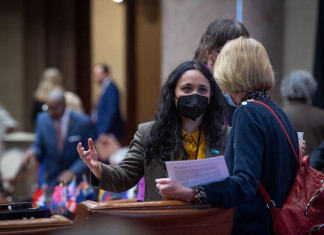The village of Red Hook is well on its way to completing the first phase of long-overdue improvements to its water system.
The current water infrastructure dates back to 1937. In all, officials believe the system needs about $8.9 million worth of repairs, to be broken into several phases. The current $1.2 million project focuses on wellfield improvements, which includes the seven active wells and pumps that draw from an underground aquifer off Fire House Lane.
Since the work started on Feb. 4, all seven wells have been inspected, cleaned, and if necessary, repaired in order to maximize capacity. Variable speed pumps, which are more energy efficient, are being installed, according to Mayor Ed Blundell.
“The wells vary in depth, some are 300 feet deep, some are only 50,” Robert Flores of C.T. Male Associates said at the Village Board’s March 4 meeting, explaining how the engineers measure the amount of water coming into a well, per foot of well, before and after the reconditioning.
As a result of the fixes, he added, “we’re seeing [the output] basically doubling.”
According to Blundell, these improvements are necessary in part due to a mandate from the Dutchess County Department of Health that dates back to a letter received in 2010, before he came into office.
The county wanted the village to be able to measure how much water is produced—which will require flow meters to be installed on each well—in order to plan for future development and increases in consumption.
In addition, the village is getting a back-up generator in the pump house a welcome addition, Blundell said. “We only have enough storage capacity in the elevated tank to last a day, day and a half if we lose power,” he said. All the wells and pumps will be equipped with high tech-monitoring systems, which will allow for remote monitoring and alerts when there is a problem.
Finally, all 827 water meters in the village will be replaced, starting April 22. Notices have been mailed requesting residents to schedule a time for the service. Representatives of National Metering, which is doing the work,“will have ID, uniforms, and badges for residents to easily identify,” Blundell said.
“When I first came into office, I began noticing there were pages of estimated bills… sometimes I would see as many as 300 estimated bills,” Blundell told The Observer.
Residents would receive an estimated bill if their meter was believed to be broken or not reading accurately.
Once all the new meters are installed, village officials hope to have a better sense for how much water is being used and paid for. “We might be selling enough water, we just weren’t billing for it,” he said.
The project is being funded by a loan of up to $1.24 million from the U.S. Department of
Agriculture (USDA). The loan has a 2 percent interest rate, to be paid back over 38 years, which is $49,000 per year, according to Blundell’s calculations. However, the USDA only issues the funds once the project is completed, so the state’s Environmental Facilities Corporation is providing the upfront monies at an interest rate of .045 percent.
According to Blundell, the project should be completed by June.
“The system [has provided] roughly 2,200 people with clean and pure water and it still does, so we’re proud of that,” he said.
Phase 2 of the water project, an overhaul of the village pipes, remains on a wish list until officials can pursue funding for it.







Facebook Comments